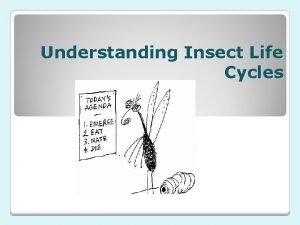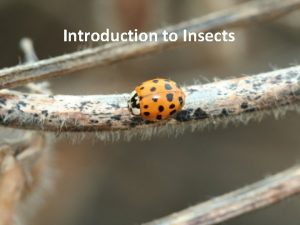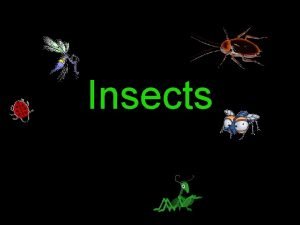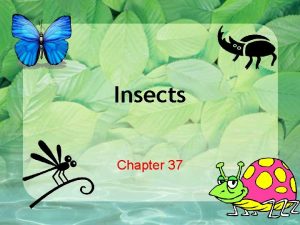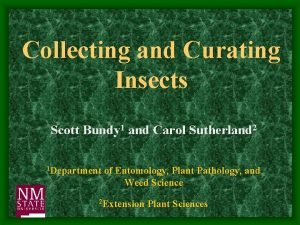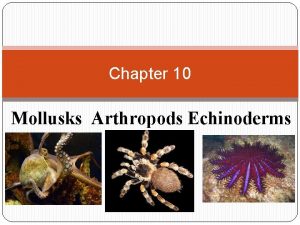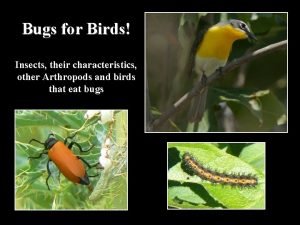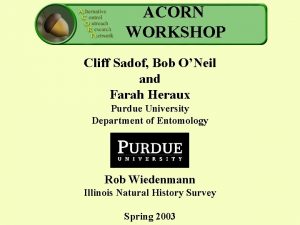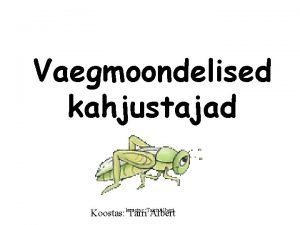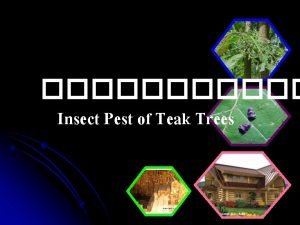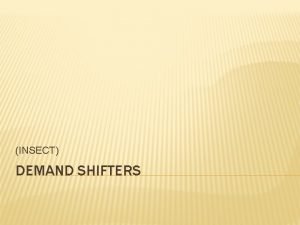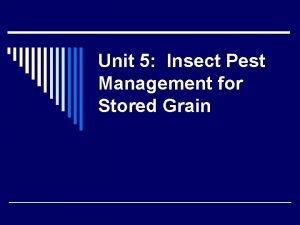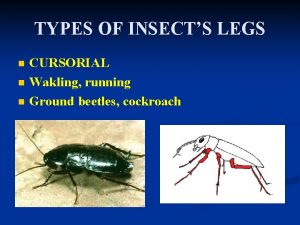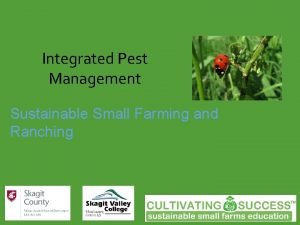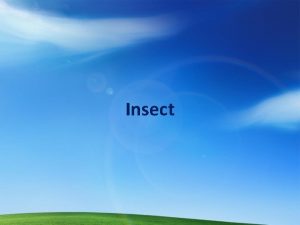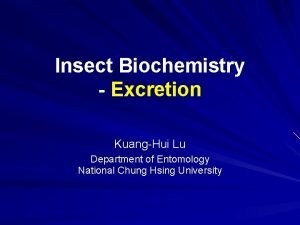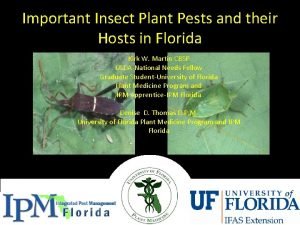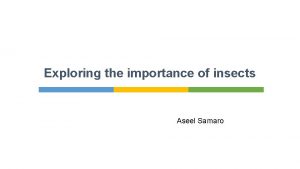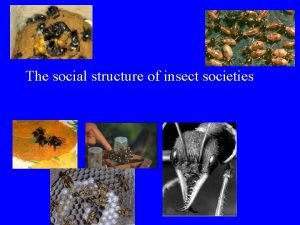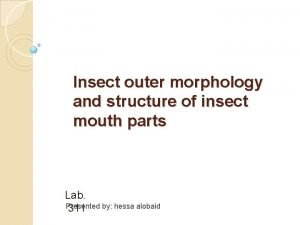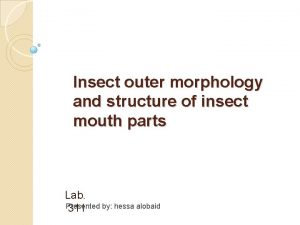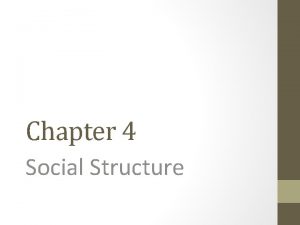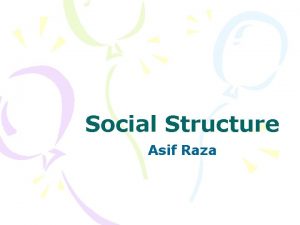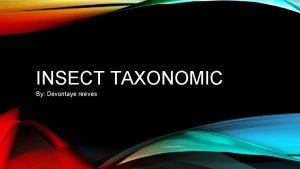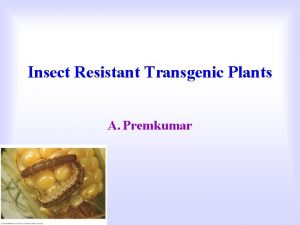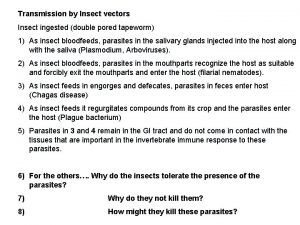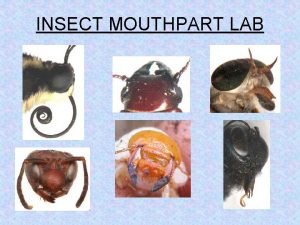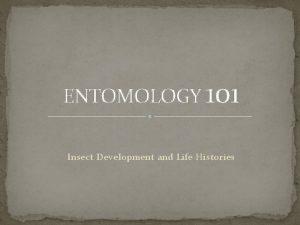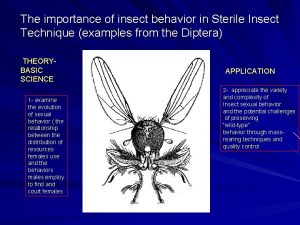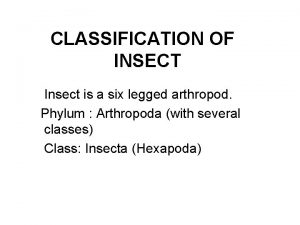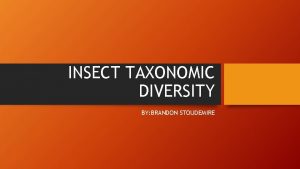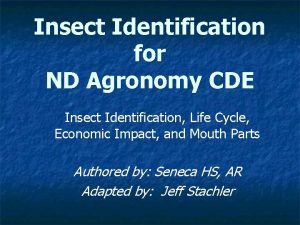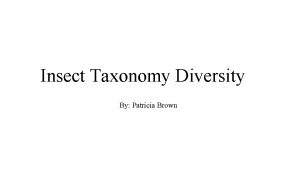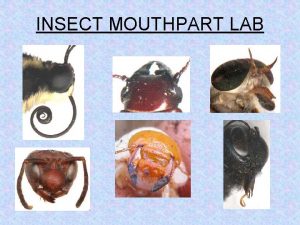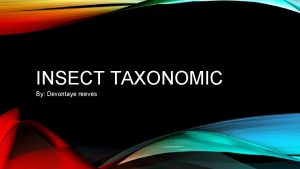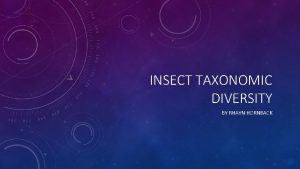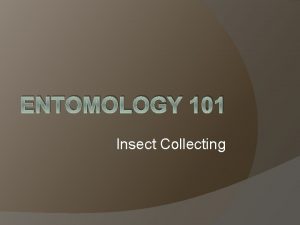The social structure of insect societies Downloaded from





























- Slides: 29

The social structure of insect societies (Downloaded from http: //chittkalab. sbcs. qmul. ac. uk/chittkalab/Teaching/Invertebrates/insect%20 sociobiology. ppt on 27 October 2015)

What is different between insect societies and swarms of locusts, fish or birds?

The social insects have royalty! • Social Hymenoptera (ants, wasps, bees) have a queen • Social Isoptera (termites) have a king & queen • The queens (and kings) are typically long lived (15 years in termites, 4 years in honeybees) • Their sole task is often reproduction (while other individuals are often sterile and don’t reproduce) Western drywood termite, Incisitermes minor Honeybee Apis mellifera queen

Queen, king, soldiers and workers in termites

Queens are not genetically different from workers! • The question of whether a female individual turns out as a queen or worker is dependent on the food that she receives as a larva. • In honeybees, larvae turn to queens when food nectar contains more than 35% hexose, and workers when there is less than 10% hexose • Workers feed “queens to be” with a mandibular gland secretion called “royal jelly” which ensures that bee queens live for 2 -4 years (rather than 7 -8 weeks as in workers) • In addition, the queen is much larger, has bigger ovaries, and spermatheca • Can lay 1500 eggs / day!

Characteristics of insect societies • They live in groups of closely related individuals • Individuals are usually faithful to their “family” • Often live in a confined locality (“nest, hive”) In eusocial insects • Overlapping generations: parents live with offspring • Members collaborate in raising the offspring • Sterility of a large number of individuals of the colony (e. g. “workers”, “soldiers”): reproductive division of labour

Degrees of sociality (after Michener 1969) • Solitary (none of the features on previous slide) • Subsocial: the adults care for their own young for some period of time (e. g. cockroaches) • Communal: insects use the same composite nest without cooperation in brood care (digger bees) • Quasisocial: use the same nest and also show cooperative brood care (Euglossine bees) • Semisocial: in addition to the features in quasisocial, also has a worker caste (Halictid bees) • Eusocial: in addition to the features of semisocial, there is overlap in generations (Honey bees): offspring assist parents

Size of insect societies • In honeybees, one queen and up to 40, 000 workers • In bumblebees, one queen and 20 -500 workers • In wasps, 1 to 1000 s of queens and 1000 s to millions of workers • In ants, 1 to over a million queens; up to many million workers • One Japanese red wood ant colony contains 307 million ants, including some 306 million workers and about 1. 1 million queens. • In Hymenoptera, the workers are invariably female; the males are good only for one thing: sex. Termites also have male workers

Success of the eusocial insects • In the tropics, one third of total biomass (animal & plant combined!) is made up of social insects! • Number of species of social insects (>11. 000) is by far higher than the number of mammal species (~4500)

Evolution of eusociality in different taxa Insect order common names frequency of evolution of eusociality Hymenoptera Ants, wasps, bees, sawflies 11 Isoptera Termites 1 Homoptera Gall-forming aphids 1 Coleoptera Bark-nesting weavils 1 Thysanoptera Gall-forming thrips 1 Non-insects Snapping shrimps and naked mole rats 2 Total 17

A mammal with queen, kings, and a sterile worker caste • Naked mole rats

Reproductive division of labour • In bees and ants, for example, the queen typically lays all the eggs • Sterile individuals (workers, soldiers etc. ) do all the other work, i. e. nest construction, feeding the young, collecting food, nest defence etc. – in short, they help the queen with maximising its fitness, while foregoing to produce their own offspring.

Altruistic suicide? • In many social insects, workers not only forego reproduction, but also their own life, “for the good of the colony”

Altruism and Darwinism? • The theory of evolution predicts that a trait (including a behaviour) can only be successful if it aids its bearer to maximise its fitness (i. e. number of offspring produced) • This means that a behaviour should be favoured by selection if it helps an animal to produce many copies of the gene that controls the behaviour. • How can altruism be favoured by natural selection?

Why do the workers in social insect colonies forego reproduction? • “But with the working ant we have an insect differing greatly from its parents, yet absolutely sterile; so that it could never have transmitted successively acquired modifications of structure or instinct to its progeny. It may well be asked how is it possible to reconcile this case with theory of natural selection. ” (Charles Darwin)

William Hamilton’s concept of inclusive fitness "I had realized from experience that university people sometimes don't react well to common sense and in any case most of them listen to it harder if you first intimidate them with equations. “ Hamilton • • • Traditional “direct” fitness is counted as the number of offspring produced. Inclusive fitness means that you can still have some fitness if yourself produce no offspring – by considering other individuals that share genes with you. For example, you share 50% of genes with your children – hence having two children will mean, on average, that you have produced one full copy of your genome. (Hence if you commit altruistic suicide to save more than 2 of your children, you have won!) Any full sibling (brother or sister) shares 50% of your genes, and their children share 25% of their genes with you. Thus, being an uncle or aunt to 4 children is as good as having 2 children of your own! You can increase your own fitness by helping a close relative bring up children!

Haplodiploid sex determination in all Hymenoptera • Haploid male bee copulates with diploid female -> haploid sperm is stored in female bee’s spermatheca • When female “wants” to produce son, she lays an unfertilised (haploid) egg -> male offspring • To produce female offspring, mother needs to add sperm to egg as it passes down oviduct • Only 2 chromosomes shown here

The queen can decide on the sex of her offspring! • In honey bee combs, large cells are for drones (males) and small ones for workers (females) – the queen puts only haploid (unfertilised) eggs into large cells, and only diploid (fertilised) ones into small cells.

Fire ant: efficient use of sperm by the queen • Like in honeybees, the queen of fire ants can also actively determine the sex of her offspring • On average, only 3 sperm are used to produce one fertilised egg (female offspring)

Hymenopteran workers are more related to their sisters than to their (potential) offspring (Hamilton’s concept of “supersisters”)

Thus haplo-diploidy implies that • it might be more beneficial for a worker to help raise more sisters (workers and new queens) than to reproduce on her own • this is because the average relationship between sisters is higher (0. 75) than between workers and their (possible) offspring (0. 5) • this might explain why the haplodiploid Hymenoptera have evolved eusocial systems more than any other insect order

Coercion – are workers forced not to reproduce? • In many species, workers can lay (unfertilised) eggs, which are haploid and will turn into males • Queens “control” the reproduction of their workers by pheromones, physical “bullying” and actively eating eggs by workers

Queen/worker dimorphism allows coercion (Tom Wenseleers) Bombus terrestris Apis mellifera Nannotrigona melanocera Vespula vulgaris Atta cephalotes Dorylus wilverthi

Hamilton’s supersisters idea holds only if queens are singly mated (i. e. all workers have only one father) • but queens of many species (e. g. honeybees, some ants) mate with multiple partners, and store all of their sperm • the result is that there are several “subfamilies” of sisters that are closely related (i. e. share the same father) in a colony

Worker policing (F. Ratnieks) • In cases where queens mate with multiple fathers, workers often patrol the colony to ensure that other workers don’t lay eggs • They eat other worker’s eggs and attack or immobilise reproductively active females In two ant species, individuals about to reproduce are detected by nestmates and immobilised. In A the queen has smeared the culprit with a chemical, and workers physically prevent it from doing anything at all. In B the “black” worker hold the “white worker” captive for days, then turns it over to another worker for imprisonment

Altruism in aphids • Four species of aphids in which sterile soldiers (left) with enlarged grasping legs and short stabbing beaks protect their more delicate reproducing colony mates (right)

Selfish behaviour in aphid clone invaders • Gall-defending aphid colonies may contain intruders that have come from elsewhere. Although these outsiders may make up a substantial proportion of the group, almost no newcomers take part in defence of the gall. Instead, defenders are supplied almost exclusively by the colony’s native population (Alcock)

Thrips – a queen (left) and sterile soldier (right)

Life cycle of a bumblebee colony • new queens mate in summer • all other individuals of colony (old queen, workers, males) die before autumn • new queen overwinters and founds new nest in spring • early in colony development: sterile workers produced • later in colony development: new queens and males produced • when colony becomes large and queen old, queen “loses control”: workers start “rebellion”: attacking queen, and laying their own eggs • old queen dies, workers take over reproduction (but produce only (haploid) males)
 Task #1 new shoes
Task #1 new shoes Social thinking adalah
Social thinking adalah Social thinking social influence social relations
Social thinking social influence social relations Firefly life cycle
Firefly life cycle A student examines the winged insect shown below.
A student examines the winged insect shown below. Mandibulate type mouth parts are seen in
Mandibulate type mouth parts are seen in Saprophore
Saprophore 3 main body parts of an insect
3 main body parts of an insect Characteristics of an insect
Characteristics of an insect Insect point punch
Insect point punch Label the external structures of the insect below
Label the external structures of the insect below Characteristics of an insect
Characteristics of an insect Silly farah insect
Silly farah insect Harilik vahustaja
Harilik vahustaja Extemporaneous compounding worksheet
Extemporaneous compounding worksheet Spider is an insect true or false
Spider is an insect true or false Pest of teak
Pest of teak Shifters in demand
Shifters in demand Insect-resistant packaging solutions
Insect-resistant packaging solutions Grain insect
Grain insect Pollen basket
Pollen basket Predatorsl
Predatorsl Insect
Insect Insect resurgence
Insect resurgence Neonicotinoids
Neonicotinoids Malpighian tubules
Malpighian tubules Artrza
Artrza Insect egg
Insect egg Assel insekt
Assel insekt Studying
Studying



